

|
| articles | forbidden stories I-State Lines resources my hidden history reviews | home | ||

Writing/Film Dear Aspiring Writers: The Worst Advice You'll Ever Read A Literary Look at I-State Lines Spirited Away: Decay and Renewal An American Poem (Robinson Jeffers) Taoist Chinese Poems 11 more in archive American Identity Hapas: The New America Can You Tell What I am? Part I Can You Tell What I am? Part II Only in America Self-Reliance Cultural Commentaries On Hatred and Anti-Americanism Anti-Americanism Part 2 Anti-Americanism Part 3 French-Bashing Kroika! Chronicles This Blog Sells Out Doom and Gloom Sells The Kroika Mascot-"Auspicious Pet" Wal-Mart and Kroika Kroika and Starsbuck Take a Hit Kroika Ad 1 Kroika Ad 2 Kroika Ad 3 Unfolding Crises: Asia China: An Interim Report Shanghai Postcard 2004 Corruption and Avian Flu: China's Dynamic Duo Exporting the Real Estate Bubble to China Is the Bloom Off the China Rose? 9 more Battle for the Soul of America Katrina, Vietnam, Iraq: National Purpose, National Sacrifice Is This a Nation at War? A Nation in Denial Why Is This Such a Tepid Time? That Price Isn't Cheap, It's Subsidized U.S. Fascists Seek Ban on Cancer Vaccine The Truth About Christmas 10 more Financial Meltdown Watch What This Country Needs Is a... Good Recession Are We Entering the Next Age of Turmoil? Doubling Down on 5-Card No-See-Um A Rickety Global House of Cards Are Japan and Germany Truly on the Mend? Unprecedented Risk 2 Could One Rogue Trader Bring Down the Market? Worried about Inflation? Stop Measuring It Economy Great? Bah, Humbug Huge Deficits and Huge Profits: Coincidence? Who's The Largest Exporter? Three Snapshots of the U.S. Economy 21 more Planetary Meltdown Watch The Immensity of Global Warming Sun Sets on Skeptics of Global Warming Housing Bubble Watch Housing Bubble? What Bubble? Housing Bubble II Housing Bubble III: Pop! Hidden Costs of the Housing Bubble Housing Market Slips Toward Cliff Housing Market Demographics Oil/Energy Crises Whither Oil? How much Is a Gallon of Gas Worth? The End of Cheap Oil Natural Gas, Naturally High Arab Oil Money and U.S. Treasuries: Quid Pro Quo? The C.I.A., Oil and the Wisdom of Crowds The Flutter of a Butterfly's Wings? A One-Two Punch to a Glass Jaw Outside the Box How to Make a Favicon Asian Emoticons In Memoriam: Winky Cosmos The Wheeled Vagabonds Geezer Rock Overload In a Humorous Vein If Only Writers Had Uniforms Opening the Kimono One-Word Titles Complacency Nostalgia Praxis Keys to Affordable Housing U.S. Conservation & China Steve Toma, Me & Skil 77s: 30 years of Labor Real Science in the Bolivian Forest Deforestation and Sustainable Forestry The Solar Economy (book) The Problem with Techno-Fixes I Love Technology, I Hate Technology How To Blow off Web Ads and More Health, Wealth & Demographics Beauty of the Augmented (Korean) Kind Demographics and War The Healthiest Cold Cereal: Surprise! 900 Miles to the Gallon Are Our Cities Making Us Fat? One Serving of Deception Is Obesity an Inflammatory Response? Demographics & National Bankruptcy The Decline of Europe: A Demographic Done Deal? Landscapes Selling the Landscape The Downside of Density Building Heights and Arboral Roots Terroir: France & California L.A.: It's About Cheap Oil The Last Redwood Airport Walkabouts Nourishment The French Village Bakery Ideas What Is Happiness? Our Education System: a Factory Metaphor? Understanding Globalization: Braudel Can You Create Creativity? Do Average People Know More Than Their Leaders? On The Impermanence of Work Flattening the Knowledge Curve: The "Googling" Effect Human Bandwidth and Knowledge Iraqi Guangxi Splogs, Blogs and "News" "There is no alternative to being yourself" History The Strolling Bones: Rock of Ages Bad Karma: Election Fraud 1960 Hiroshima: First Use All the Tea in China, All the Ginseng in America Friday Quiz Quiz #1: Pet Obesity Essential Books The Misbehavior of Markets Boiling Point (Global Warming) Our Stolen Future: How We Are Threatening Our Fertility, Intelligence and Survival How We Know What Isn't So Fewer: How the New Demography of Depopulation Will Shape Our Future The Coming Generational Storm: What You Need to Know about America's Economic Future The Third Chimpanzee: The Evolution and Future of the Human Animal The Future of Life Beyond Oil: The View from Hubbert's Peak The Party's Over: Oil, War and the Fate of Industrial Societies The Solar Economy: Renewable Energy for a Sustainable Global Future The Dollar Crisis: Causes, Consequences, Cures Running On Empty: How The Democratic and Republican Parties Are Bankrupting Our Future and What Americans Can Do About It More book reviews Archives: weblog January 2006 weblog December 2005 weblog November 2005 weblog October 2005 weblog September 2005 weblog August 2005 weblog July 2005 weblog June 2005 weblog May 2005 What's New, 2/03 - 5/05 
|
Welcome, readers, welcome. Please browse this month's entries and the archived wEssays listed in the sidebar. If nothing here strikes your fancy, skim through my recently published articles (generally in the San Francisco Chronicle) and my archives back to 1995. I would be honored if you link any essay to your website, print a copy for your own use or add my RSS or Atom feed. And of course I appreciate your recommendations of this weblog and your comments: csmith@oftwominds.com. February 28, 2006 Comparing the Nasdaq to the Depression-Era Dow 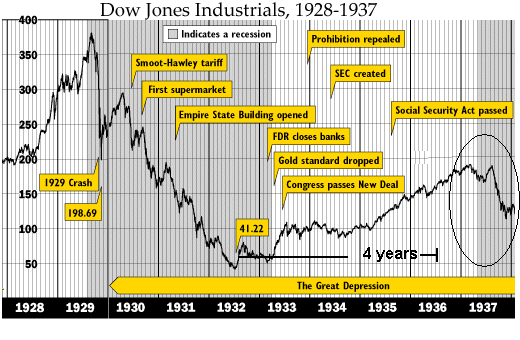
* * * * * * * * * * * * * * * * * * * * * It is instructive to compare the last great stock market bubble burst with the current unwinding of the great Nasdaq tech bubble. The most obvious features of the Dow Jones Industrials stock bubble displayed on the graph above, covering the years 1928-1937, are rather eerily present in the Nasdaq graph below: 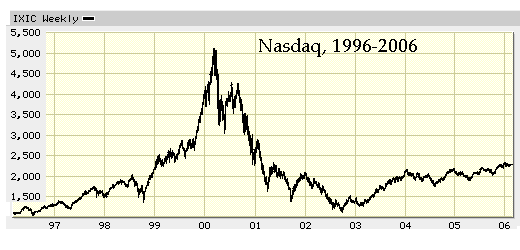
* * * * * * * * * * * * * * * Yesterday's entry pointed out that the four-year "presidential cycle" predicts a stock market bottom late in 2006, and it is perhaps not entirely coincidental that a comparison of these two charts suggests the same conclusion: An exhaustion of the "false prosperity" "echo of the bubble" which is nearing its wealth-destroying conclusion, four years after the post-bubble bottom. As if this were not enough evidence to suggest caution, it should also be noted that bull markets usually last about 3 years. The current euphoria has run 3.5 years, and will be extremely long in tooth at 4 years come October 2006. While it's amusing to study Fed Chairman Bernanke''s comments, it might be more profitable to study objective charts. February 27, 2006 Loaded for Bear 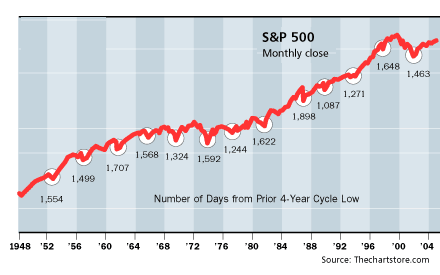 Before you get too euphoric about the U.S. stock market and economy, read this
interview in Barrons:
Loaded for Bear.
Before you get too euphoric about the U.S. stock market and economy, read this
interview in Barrons:
Loaded for Bear.
One of the key points in the piece is the "presidential cycle," a technical analysis mainstay for the past 50 years. The cycle is based on the simple observation that the stock market hits its low around the mid-point between presidential elections. As the accompanying chart shows, this pattern has repeated with remarkable consistency for the past 50 years. In recent history, it worked like this: Bush I elected 1988, recession late 1990. Clinton elected 1992, stock market low in 1994. Clinton re-elected 1996, Asian Contagion/Long Term Capital Managament meltdown, 1998. Bush II elected 2000, stock market bottomed October 2002. So look at the calendar, and count the days. Looks like a stock market bottom is looming around October 2006. And as the analyst in the article pointed out, the stock market has always been the leading indicator for recession. As the market goes, so goes the economy. February 25, 2006 Your Tattoo in 50 years  Here is a photo of my grandfather Hiram in his living room with me and my brother,
circa 1971. He was 70 years old. Can you see his tattoos? During his U.S. Navy service
in the Far East (China) in 1919-21, he'd picked up a few trinkets like a Chinese lock
and Chinese coins, and also some very impressive body art: Chinese dragons and American
eagles.
Here is a photo of my grandfather Hiram in his living room with me and my brother,
circa 1971. He was 70 years old. Can you see his tattoos? During his U.S. Navy service
in the Far East (China) in 1919-21, he'd picked up a few trinkets like a Chinese lock
and Chinese coins, and also some very impressive body art: Chinese dragons and American
eagles.
Though we were fascinated by these relics of his exciting youth, we rarely got to see them; you will note the long-sleeved shirt in the photo. As a result of the large tattoos on his forearms, my grandfather wore long-sleeved shirts his entire life. We only got to see the dragons and the eagle on his chest when he went swimming, which was rare. Like the deafness brought on by his proximity to the destroyer's 5-inch guns, not everything from that exciting youth turned out to be positive--including the tattoos. Try, if you can, to imagine how dated the fashions of 1920 seemed in 1971. Now imagine how dated the fashions of 1971 seem today. Now imagine how idiotic and foolish the fashions of today will seem in 2036. While it would be easy to dismiss the current craze for tattoos as just another dumb fad that will fade with time, it may be symptomatic of a darker phase in American culture, one in which externalizing one's character reigns supreme. Want to express your masculinity, daring, rebellious spirit, great love, etc.? Well how about doing something truly difficult, and keeping it to yourself, rather than fall for the ersatz bravado of a tattoo? What's truly difficult is restraining your inner demons, being a steadfast, unselfish parent, learning a demanding trade--challenges which reveal a few hours of pain getting a tattoo as trivial and trivializing. There is one exception to that: tattoos in memoriam to those killed in Iraq: Tattoos Honor Marines Killed In Iraq and Help the Survivors ( Wall Street Journal, February 15, 2006). Maybe if more Americans had tattoos reminding us all of the personal cost of war, we as a nation would be more aware of the sacrifices made by those in uniform, and what's at stake in this ongoing war. February 24, 2006 Friday Quiz: Wine and Alzheimers Q. Could a moderate intake of red wine cut the risk of contracting Alzheimers? A. Evidence suggests yes. According to a report in Scientific American, Wine Compound Attacks Alzheimer's Agent: A chemical compound in wine reduces levels of a harmful molecule linked to Alzheimer's disease. In a recent study, resveratrol--one of several antioxidants found in wine--helped human cells break down the molecule, which contributes to the lesions found in the brains of Alzheimer's patients. Fortunately for teetotalers, the compound is also found elsewhere. Resveratrol is a natural polyphenol occurring in abundance in several plants, including grapes, berries and peanuts.The same compound may also prolong life, as described in another article from Scientific American: Grape Compound Prolongs Life, Fish Study Concludes. It seems the Greeks and Romans may have been on to something. February 23, 2006 Doodles from Math Class  A young friend of mine, age 12, recently assembled an animation of doodles she'd
drawn in math class (after finishing the classwork, of course). I find it very
charming and hope you'll enjoy it as a change of pace from the usual doom-and-gloom
entries on the housing bubble, etc.
A young friend of mine, age 12, recently assembled an animation of doodles she'd
drawn in math class (after finishing the classwork, of course). I find it very
charming and hope you'll enjoy it as a change of pace from the usual doom-and-gloom
entries on the housing bubble, etc.
Astute observers may note the influence of manga-style art on the young prodigy's handiwork. The animated transitions are courtesy of Paint Shop Pro's Animation tool, which offers a pallette of transitions for both text and images. February 22, 2006 The Bubble Mentality 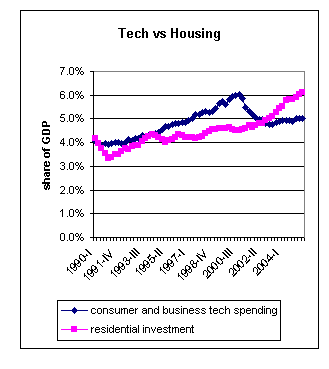 By any measure objective, it's long been official:
we're in a housing bubble. Here's yet more evidence. This little chart compares housing
to the tech stock bubble of 2000 as a percentage of GDP. (For more measures of the
bubble, scroll down to the links on the left listed under "Housing Bubble Watch." Also,
scroll down to the entries dated February 4, 9 and 18.)
By any measure objective, it's long been official:
we're in a housing bubble. Here's yet more evidence. This little chart compares housing
to the tech stock bubble of 2000 as a percentage of GDP. (For more measures of the
bubble, scroll down to the links on the left listed under "Housing Bubble Watch." Also,
scroll down to the entries dated February 4, 9 and 18.)
Quite understandably, the real estate and housing industries are busy unearthing all the reasons why the bubble is sustainable, and indeed, not a bubble at all; but this stubborn, even desperate confidence eerily recalls the dot-com pundits' certainty that "this time it's different" and the tech boom was more or less eternal. Alas, the Nasdaq fell from 5,000 to 1,100--a drastic decline no one predicted. The psychology of a bubble is peculiarly selective. If anyone had predicted Nasdaq would climb from 1,000 in 1995 to 2,000 in 2000, everyone would have been delighted with that doubling. Yet by the time it quintupled to 5,000, then everyone took the extraordinary rise as inevitable and even rational. Now we find the same psychology at work in housing. If someone had predicted that a $200,000 house in 1995 (the median home price in the S.F. Bay Area at that time) would rise in value to $300,000 in 2005, the buyer would have been ecstatic with this 50% gain. Yet now that the house has tripled to $600,000, the owner feels entitled to that fantastic rise, and fully expects continued gains--just like the buyer of tech stocks felt in late 1999 as Nasdaq seemed to be on a permanent tear upward. And just as no one predicted a massive decline in the Nasdaq in 2000, no one is predicting a crash in real estate values. Yet history has shown that bubbles pop, some violently and some slowly, but none stay aloft forever. The standard line in the real estate industry is that housing will "cool off" and "only" go up by "single digits" per year for a few years to "digest the gains." This sounds like it was copied and pasted from stock market gurus' predictions in 2000. If history is any guide, bubbles--be they of tulips, tech stocks or houses--tend to re-trace all the way back to their value before the bubble. Could $600,000 houses fall back to being worth $200,000? This seems incomprehensible to the average home buyer, because like stock investors in 90s, they've only known a world of ever-rising real estate values. But we're about to enter the world on the other side of the mirror, one in which housing values only drop. How could this be? It's very easy. Just look to an oversupply of product (housing), an exhaustion of demand (all the foolish people have already bought at the top), and then a rise in the cost of money. If mortgage rates rise to 9% from 4.5%, then guess what? Buyers can only afford a house of half the value. With a 4.5% mortgage, they can afford the $500,000 mortgage payment. But at 9%, they can only afford to borrow $250,000. By the laws of supply and demand, the price of housing must also eventually fall in half. Don't think it could happen? Please re-wind your mental tape to the Spring of 2000, and re-read all the predictions of permanent boom and permanent bubble valuations. February 21, 2006 Are We Poor Or Prosperous? The 10%-90% View 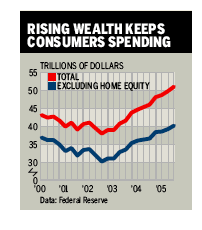 Are we in over our heads in debt and heading for the poorhouse, or are we flush
with trillions in easy cash, just waiting to be lavished on more goods and services?
Shouldn't the answer be obvious? It is to those happy-happy sources like
BusinessWeek which provide a steady supply of reasons why everything economy-wise
is just peachy, or even super-peachy.
Are we in over our heads in debt and heading for the poorhouse, or are we flush
with trillions in easy cash, just waiting to be lavished on more goods and services?
Shouldn't the answer be obvious? It is to those happy-happy sources like
BusinessWeek which provide a steady supply of reasons why everything economy-wise
is just peachy, or even super-peachy.
Supporting the peachy cause is BusinessWeek's little chart of rising wealth (right) and their accompanying article Why More Households Are Feeling Flush. The thesis is simple: household wealth has climbed by $10 trillion since 2001, so no wonder Americans are spending money like water--they're rich and constantly getting richer due to the rise in their housing and stock portfolios. Sounds pleasant, but BusinessWeek left out the important statistic: what percentage of American households are participating in the non-housing part of rising wealth? As we all know, 90% of the non-housing wealth in the U.S. is held by the top 10% of the population, meaning that BusinessWeek's glorious increase in wealth is actually highly concentrated in a few hands, not spread around like their chart might suggest to the unwitting or gullible. A more accurate nationwide look--and a far more sobering one--can be gained by reading a recent piece on Yahoo Finance: Americans' Debt: Worse Than You Think?: According to Kasriel's calculation, last year Americans spent approximately $472 billion more than they earned after taxes -- a negative savings rate of 5.2 percent. That spending is double the previous year -- and a record high.Sounds like 90% of us are heading for debtor's prison, while the 10% who own 90% of the stocks and bonds are feeling just fine. For how long, no one can say, but if the 90% stop spending, how long before the top 10% start feeling a little less wealthy? Put another way--if housing falls apart under an avalanche of foreclosures, how long can stocks keep rising? How long will it take for that "free" $10 trillion in wealth to vanish in a haze of bubble-popping panic? Perhaps not as long as you might think. February 20, 2006 Everybody's Got Problems, But... As even occasional visitors here know, the economic headwinds building against the U.S. are formidable. Throw in a struggling education system, geopolitical and environmental woes and it's easy to be pessimistic about the U.S.'s future. But after considering Germany's problems--this, the strongest economy in the E.U.--I'll take America's problems any day. The structural plights of Germany were recently explored in a multi-story feature in The Economist. At the risk of boring you with long excerpts, here is a precis of Germany's formidable structural challenges in education, immigration and integration. First up is their education system, which funnels kids into either the working class or university track at an absurdly young age: Like other European countries, Germany from the Middle Ages developed a school system based on class. But whereas most other European countries have since moved on to more inclusive systems, Germany has essentially stuck to a three-tier structure: the Hauptschule (for students who hope to go on to an apprenticeship), the Realschule (whose graduates typically take middling white-collar jobs) and the Gymnasium (awarding the Abitur that admits the holder to university). Only at the Grundschule (elementary school) are pupils from all ability groups taught together.Then there's the German healthcare system, which is hardly a model of efficiency: Mr Lauterbach's academic speciality is Germany's health-care system, and to him the health-care industry is proof that German-style corporatism can be at least as costly as backroom deals. Just like education, he says, it is a system that protects privileges without adding any value: “It is not only inefficient, but also creates injustice.”Lastly, there's the structural discrimination against immigrants and appallingly low social mobility of the second and third generations: The third generation of Turkish immigrants, in particular, is increasingly marginalised— and not just because of the school system and the labour market. The exclusion starts when they become teenagers, explains Mr Ersan: they often switch to a Turkish football club at that point because their old German club makes it clear to them that they do not really belong there. When they have finished school, they are rarely offered even an unpaid internship, let alone an apprenticeship.On top of these problems, Germany is faced with a very low birthrate (1.3 vs. 2.1 for the U.S.), which guarantees a shrinking population, an ever-increasing need for more foreign workers to keep the social security system afloat, and thus ever-larger challenges in education, social mobility and discrimination. The "haves" in every society hold all the levers of power, but few other nations seem to cut their immigrants so thoroughly out of the economic and power pie as does Germany. The U.S. has all the same issues, plus an economy tottering on the edge of fiscal ruin, but the bottom line is: in which country would you rather be an immigrant? I think the choice is obvious. February 18, 2006 The Housing Conundrum 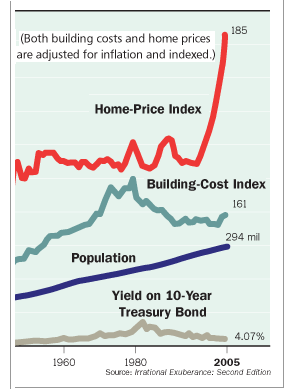 The headlines blare that the housing boom is still full speed ahead:
Housing Construction Soars in January at Quickest Pace in 30 Years:
The headlines blare that the housing boom is still full speed ahead:
Housing Construction Soars in January at Quickest Pace in 30 Years:
Some economists, however, said that a 6.8 percent rise last month in building permits, which are not affected by the weather, could be a signal that housing activity will not slow as much this year as previously thought as long as mortgage rates do not rise too quickly.That's nice, especially coming from a mortgage broker, but does anyone else wonder if the rapidly increasing supply might finally get ahead of demand? Or what if demand is slipping just as supply is dramatically increasing? Here in the Bay Area, demand is visibly falling, as reported in the S.F. Chronicle of February 18: Home Sales Falter -- Hints Of A Slowdown. This dynamic is the heart of capitalism: high demand and fat profits attract more producers and more production, eventually meeting demand. In theory, a balance is magically achieved; in practice, supply typically overshoots demand. When this happens, prices drop as demand withers. Then, as supply continues to flood the market, prices plummet as producers try to cut their losses by dumping inventory. If you're dumping a 100,000 laptop PCs, then you're not in too much trouble. Worldwide demand soaks up 40 million PCs a year, so you'll have little problem finding buyers at a bargain price point. But a house or condo is not a PC. People don't buy one every three years, and when they do buy, they typically sell the house they already own, maintaining the inventory of unsold houses. As we know, housing is exquisitely sensitive to the cost of money in a way that PCs are not; even a modest rise in interest rates will change a lot of minds. And why would interest rates rise? How about because inflation is rising at the producer level? Core Producer Prices Rose By 0.4% During January, reports the Wall Street Journal, which works out to an annual rate of 5%. How long do you reckon mortgages can stay ay 6% if wholesale inflation is running at 5%? Short answer: they can't. Unlike a PC, whose components can be grabbed off the shelf and slapped together in a few minutes, a house takes a long time to plan and build, and carrying an inventory of unsold houses is terribly expensive. So the soaring rate of new construction may not be something to cheer. If supply far outstrips demand, prices will fall. The greater the imbalance, the farther prices will fall. Builders starting all these new homes may rue the day they pulled all those permits and committed themselves to the loans. Time will tell. February 17, 2006 Friday Quiz: The E.U.'s Biggest (Legal) Drug Consumers Which nation consumes more prescription psychotropic drugs--Britain, France or Germany? The per capita consumption in France of anxiolytic, hypnotic, antidepressant, and neuroleptic drugs is about three times greater than in Germany or Britain: 11% of adults in France take psychotropic drugs at least once a week and for at least six months. A national survey has shown that one in seven prescriptions include at least one psychotropic drug and that 83% of such prescriptions are made out by general practitioners. France tackles psychotropic drug problem February 16, 2006 Ten Guaranteed Predictions for the Future While it is certainly true no one can precisely predict future events, that doesn't mean we can't safely predict certain elements of the future. For instance, I guarantee these ten predictions will all come true by 2012: 1. A new diet will promise weight loss. Perhaps it will be cranberries, cream cheese and oatmeal bagels; perhaps not. But it will contain ordinary foods which have been "discovered" to contain fabulously powerful anti-oxidants or other compounds. 2. A massive, costly study will prove the new diet has no measurable effect on subjects' weight loss. 3. Yet another massive, costly study will prove the health benefits of regular vigorous exercise, sex and a varied diet filled with fresh fruits and vegetables. 4. The vast majority of people will continue to eat foods which are not good for them and exercise sporadically. They will, however, continue to indulge in sex. 5. A new type of cosmetic treatment or procedure will sweep first Hollywood, then the country club set and then the Oprah Nation, promising a safe way to peel years of age and general haggardness from tired flesh. 6. Exhaustive studies will find that the new cosmetic procedure's effects are not very enduring and may harm deep tissues, causing the patient to look worse than if they'd had no procedure or treatment in the first place. 7. Youth will finally drop the sagging pants look as passe and rediscover some past trend to make their own. Good prospects: gingham shirts, Nehru jackets, collarless shirts, dopey-looking hats. 8. For yet another decade, "cool" will still be cool. The Jazz Age word continues to reference itself. 9. A hot new stock will defy the pundits' low expectations and continue to climb way past any rational valuation. When the pundits and analysts finally get on board, it will plummet. 10. A new business book will propel to the best seller list, promising a new way of management, enlightened capitalism and personal growth--all in an easy-to-digest bulleted Powerpoint format. And as a lagniappe, 11. You will buy a copy of the writer's novel I-State Lines (Permanent Press, April 2006) either because you like the book or because you feel sorry for the poor, dumb unknown fool who wrote it. (OK, maybe this won't come true, but you can't blame a guy for trying.) February 15, 2006 Rooftop Gardens--Urban Crops, Urban Oases Regular readers know that I do not find any evidence that highrise towers are a satisfactory way to increase density. Much better is a uniform four-to-six story streetscape, for such a height does not darken the streets or create a highly energy-inefficient sink of elevators, glass walls and costly infrastructure. In addition to these benefits, low-rise buildings allow for rooftop gardens, which perhaps surprisingly, can provide both significant amount of vegetables and measurable reductions in air pollution. In addition to these benefits, such urban gardens also create oases of green in a gray urban world--an attribute which is hard to quantify but which we can all feel in an immediate, almost genetically progammed fashion. Here are some interesting links to more information on rooftop gardens: rooftop gardens rooftop gardens reduce smog greenroofs.com February 14, 2006 The Ultimate Valentines Day Gift: Time Employed Americans, especially those with children, almost uniformly feel pressed for time. Yet here is a study published in The Economist entitled Land of Leisure, which found that Americans have more non-work time than ever before: But why do Americans feel so harried? Weirdly, prosperity may be to blame in two ways. First, thanks to rising real incomes, an American's time is worth more now. A walk in the park is more expensive than it used to be. (When people complain to him about being too busy, Mr Hamermesh tells them that their real problem is too much money.) Second, economic advances allow people to squeeze ever more possible activities, both work and leisure, into a day, which encourages people to try to do too much.It certainly seems true that caring parents are hurrying to and fro after work, ferrying their kids to enrichment programs like ballet, music and sports which were once the exclusive perview of the wealthy. Leisure and the money to pay for such enrichment is certainly a result of prosperity, and so the thesis that more money coupled with ambitious use of leisure (non-work, non-school hours) makes sense. But what about all the people who don't have school-age children? What's behind their sense that leisure is lacking? Just for starters, how about one of these: So here's the Valentine Day tie-in: with leisure time so short (illusory or not), give your sweetie the ultimate luxury: time. Sure, dream big, but enjoy small. February 13, 2006 The "Art of Craft" Thrives The S.F. Chronicle has received over 100 emails to the "Art of Craft" pieces which ran on Saturday, a surprisingly substantial response. Even large circulation newspapers like the S.F. Chronicle rarely receive more than a handful of letters on any issue--30 letters from readers is considered a big response. Generally, they're the result of an editorial on a "hot button" issue like controlling pit bull dogs, allowing dogs to run free in parks, etc., not a series on craftspeople in the Home section. It seems people are enthusiastic about craftspeople they know, and about the work they create. February 11, 2006 The Art of Craft in the S.F. Chronicle Two feature stories I wrote for the San Francisco Chronicle ran today, launching a new series for the paper entitled "The Art of Craft": Building for the Next generation and the accompanying profile of master furniture makers Berkeley Mills: A Feel for Craftsmanship. February 10, 2006 Friday Quiz: World's Largest Oil Producers Which nations top the list of oil producers? Country and Barrels Produced Daily (in millions) Saudi Arabia 9.55 Russia 9.02 U.S. 5.13 North Sea (UK, Norway) 4.74 Iran 4.14 China 3.61 Mexico 3.32 Norway 2.69 Nigeria 2.62 Venezuela 2.56 February 9, 2006 Our Era in a Word: Greediocy My good pal and most excellent Ka'a'awa blogger Ian Lind coined a new word last week which justly describes our sad state of affairs: greediocy. To quote from Ian's February 1 entry: Greediocy: The foolish decisions made pursuing promises of easy riches. 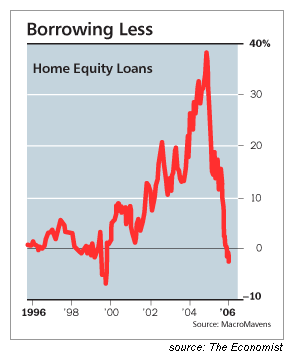 What's so refreshing about Ian's new word is that it speaks to the disturbing and
ultimately destructive mindset at the foundation of the housing "boom"/bubble: build it
quick, build it cheap and flip it fast. While the developer/homeowner is anxiously
calculating their return on investment, or gloating over yet another 15% rise in real estate
values, the built environment--that is, all the buildings which have been tossed up in the
frenzy--will still be here long after the euphoria has faded. The community at large will
be stuck with the consequences, even as the over-leveraged developers and homeowners
are filing for bankruptcy and the lenders are nailing up "for sale" signs by the score and
ordering more by the truckload.
What's so refreshing about Ian's new word is that it speaks to the disturbing and
ultimately destructive mindset at the foundation of the housing "boom"/bubble: build it
quick, build it cheap and flip it fast. While the developer/homeowner is anxiously
calculating their return on investment, or gloating over yet another 15% rise in real estate
values, the built environment--that is, all the buildings which have been tossed up in the
frenzy--will still be here long after the euphoria has faded. The community at large will
be stuck with the consequences, even as the over-leveraged developers and homeowners
are filing for bankruptcy and the lenders are nailing up "for sale" signs by the score and
ordering more by the truckload.
Think it can't happen? It appears it's already happening: The Star-Telegram newspaper (Texas) reports that "Home foreclosures continue to climb. The number of homes slated for foreclosure continues to rise in Tarrant County, with 1,101 headed to auction next month. That is a 17-year high, according to Foreclosure Listing Service. That total is up 27.6 percent from a year ago."You may think such visions are absurd, but I recommend you read a bit of history before you reject the possibility of severe declines in real estate. The last era in which borrowing, debt and greediocy rose to such heights was the late 1920s, a period of excessive speculation and debt which led to the Great Depression. At the height of the Depression (which was plumbed not in 1929, but years later in 1936-7), a glorious New York highrise was sold for the cost of its elevators. Yes, a $5 million building constructed in the late 1920s was sold for $100,000 at the bottom. Now that's what we call depreciation. To quote Jackson Brown: "Don't think it won't happen just because it hasn't happened yet." February 8, 2006 The Best Kroika Ad Ever!  In response to a critique I've received regarding my recent
Kroika cookie ads, e.g. that they've been negligently male-centric,
I've designed one featuring a female. Enjoy!
In response to a critique I've received regarding my recent
Kroika cookie ads, e.g. that they've been negligently male-centric,
I've designed one featuring a female. Enjoy!
I think this one is the best yet, for it communicates the immense power of a crisp Kroika cookie to literally change your world view from a world-weary gray funk to a brightly colored, glad-to-be-alive vibrance, transporting the lucky person consuming the Kroika into an angelic state of being. This, after all, is the most potent promise of advertising--that buying this product will effortlessly transform you into something, grand, wonderful, special, powerful, advanced, prestigious--that is, everything that you are not. And this transformation via purchase requires none of the sacrifice, labor, tenacity, open-heartedness, empathy, resilience, effort, dedication, study, practise and understanding that you would need to achieve all these good things on your own in the real world. That's why advertising works: it promises transformation without all the work, failure, and effort of real transformation and accomplishment. It plays to human's great weakness: we are fundamentally lazy, and want a quick way to riches, fame, success, love and glory. Alas, there is no such path, but we fall for the promise nonetheless. Don't you wish you had a crunchy Kroika cookie right now? February 7, 2006 Sugar-Coated Denial The financial press is chockful of glowing stories about how great the U.S. economy is and how wrong the "Bears" are about prospects for a severe decline. Nice, but under inspection the happy stories are built on sand. First up in BusinessWeek's lead story, Unmasking the Economy: Why It's So Much Stronger Than You Think. The basic thesis here is: if intangibles were awarded dollar values, all those pesky deficits would vanish in a rosy glow of rejiggered accounting. For instance, if corporate research and development and investments in education were counted as investments rather than consumption, and if already-educated immigrants' brainpower were counted as an asset, well, tens of billions would be added to the plus side of all those nasty deficits. Say what? Does having smart immigrants and parents paying college tuition suddenly erase $400 billion Federal deficits, or lower the $825 billion current account deficit? This is grasping at straws, a sugar-coating of denial. Yes, R&D contributes to future growth and blah blah blah, but it in no way reduces our dependence on foreign capital or increases our savings or fixes the Medicare nightmare. Putting dollar values on these intangibles does not reduce the unsustainability of the tangibles. 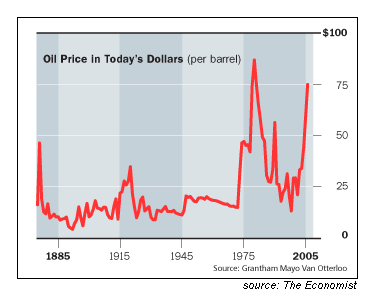 Typical of the Raging Bulls is this "Investor's Soapbox"
contributor in
Barron's Online:
Typical of the Raging Bulls is this "Investor's Soapbox"
contributor in
Barron's Online:
"The secular bear case certainly didn't pan out: consumers didn't collapse out of exhaustion; leveraged corporate balance sheets have been rejiggered; corporate profits, trade flows and international commerce stand at new records; fascinating new-technology product cycles play into globalizing consumer preferences."There's two fallacies at work here: "This time it's different," and "since it hasn't happened yet, it won't happen." What this writer is positing is this: Another contributor to Barron's Online has a more realistic view: "Not helping matters was an upward revision on Treasury's expected borrowing in the first quarter to $188 billion from what was already a massive $171 billion. Given that foreign investors hold over 54% of privately held U.S. Treasuries, yields and the U.S. dollar will be sensitive to developments in the foreign demand for Treasury debt. But, unlike 2003 and 2004, foreign central banks cannot be expected to ride to the rescue, as many already have more-than-adequate levels of foreign reserves and their enthusiasm for U.S. Treasuries has cooled."There is a major cognitive dissonance in the Bull story: if energy amd commodities keep rising, won't those rising prices eventually feed inflation and cause people to consume less oil and copper, gold, etc.? That's what classic supply and demand economics suggests will happen. Yet the Bull case is based on demand being strong no matter how high prices rise. That seems to be a case built on wishful thinking or some other flavor of sugar-coated denial. The Bear case for gold rising forever suffers from a similar disconnect. If gold doubles in price, won't that trigger some fall-off in demand for jewelry, etc.? And won't that lessening in demand cause prices to drop back? Again, the case for ever-rising gold depends on inelastic demand--something which history suggests is unrealistic. People respond to higher prices by using or buying less of whatever has jumped in price. Even oil, the most inelastic demand, can drop by 10% or more once prices dig deep enough into consumer's pocketbooks. Realistic appraisals of our dire straights are seeping into mainstream media. For instance, take a look at this excellent summary from Yahoo Finance entitled Living Hand To Mouth--and Barely Getting By. If this piece doesn't give you pause--well, you're wearing Denial Glasses an inch thick. For a view of the economy which isn't sugar-coated, consider what Jeremy Grantham, Investment strategist for Grantham Mayo Van Otterloo had to say: "Hyman Minsky was a serious economist. His thesis of stability being unstable was not at all mainstream. In fact, he had the good sense to keep writing and rewriting the point for 20 years. There is ironclad logic involved. If you have a wonderful stable world and, better yet, it is growing nicely and nothing is going wrong, you are likely as the years go by to take more risk and more risk and more risk, and the cost of taking it gets less and less because interest rates come down, and you can imagine that people will get carried away into thinking such conditions are permanent and take on record levels of debt. They think conditions will always be safe, they will always be good. And then all it takes is some small event to create instability."Sounds like a precise shorthand description of the global economy today--one without the sugar-coated denial. February 6, 2006 The Chickens Are Coming Home to Roost 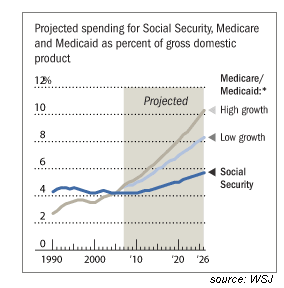 A good friend was describing the college savings plans she was starting for her
daughters, and I suggested that she avoid putting any money in U.S. equity mutual
funds until October. She replied that this was "long-term investing" with a timeline
of 6 or 7 years out, and so she wouldn't try to time the market.
A good friend was describing the college savings plans she was starting for her
daughters, and I suggested that she avoid putting any money in U.S. equity mutual
funds until October. She replied that this was "long-term investing" with a timeline
of 6 or 7 years out, and so she wouldn't try to time the market.
I then said that the country was heading into a great depression which would last 10 or more years. Her response was a stunned silence. Not that I blame her; it just seems crazy to speak of a depression when "everything is going so great." But the hurricane winds of massive wealth destruction are brewing just over the horizon, and it won't be long before intelligent, well-informed people like my good friend start seeing the whirlwind of a 10-year long storm sweeping away all the debt, wealth and excess of the past five years of phony prosperity. For your consideration: the charts which predict the storm. As described in the Wall Street Journal of 2/3/06, the medical entitlement programs alone are on course to eat up 22% pf the nation's GDP in a few decades--a share larger than the entire Federal government today. Budget Wish Lists Come and Go,But 'Entitlements' Outweigh All: But the significance of Bush's proposals and Congress's response is dwarfed by one daunting fact: Some 84 cents of every dollar the government spends is essentially committed before he and the legislators even have at it.Then there's the news which rocked the stock market: productivity drops as wages rise. Allow me to summarize these two stunning developments: Since the late 90s, the "story" was that rising worker productivity in the U.S. would enable the country to pay for the huge entitlements due the soon-to-be-retiring Baby Boomers. The hefty budget surpluses of those years made this seem possible. Alas, Bush and the Republicans gave away the $1.6 trillion (says the Wall Street Journal) surplus in tax cuts to the wealthy, so now there are deficits farther than the eye can see. Now we find that the "miracle cure" of productivity is slowing, even as wages are finally rising after 5 years of flatlining. American workers don't need to be told how this "miracle of productivity" works--benefits have been slashed, support staff axed, more work loaded onto workers with no equivalent increases in pay. But now there are fewer such ways to increase productivity, and so naturally the "miracle" goes away. The Federal budget deficit, we now learn (not exactly news if you read anything at all) is "unsustainable," and either taxes will have to double or America's favorite welfare programs for the middle-class (Social Security and Medicare) will have to be cut in half or more. The WSJ failed to mention the other elephant in the room: rising interest payments on the Federal debt. As wage inflation kicks in and productivity falls, and as the systemic inflation of rising energy costs become visible, then inflation (and thus interest rates) will have to rise. If interest rates rise to a historically middle-of-the-road 8%, the cost of the interest paid on the National Debt will double to $400 billion a year--more than the entire "discretionary" part of the budget. If you can't see the storm ahead, I fear you are in severe denial. February 4, 2006 Doom and Gloom: What's the Point? 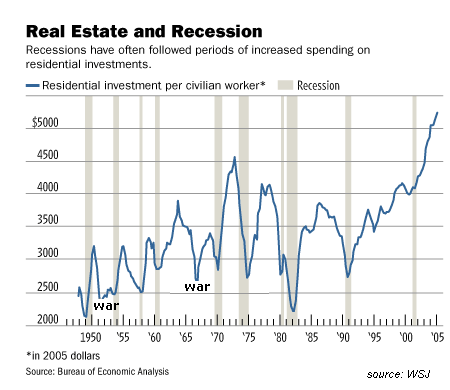 You may wonder, what's the point of this weblog's incessant doom-and-gloom forecasting
of a coming economic breakdown? The point is to protect yourself from financial calamity.
You may wonder, what's the point of this weblog's incessant doom-and-gloom forecasting
of a coming economic breakdown? The point is to protect yourself from financial calamity.
Take a look at all the charts which illustrate the many listings under "Financial Meltdown Watch" in the sidebar, and ask yourself, What if this data is true? The sources are there, so please check the accuracy and reliability of the charts yourself. If the data is true--unprecedented public and private debt loads, unprecedented trade deficits, unprecedented levels of highly leveraged derivatives, an unsustainable housing bubble poised to burst, and so on, then ask yourself: Can all these unprecedented levels of risk have no consequences? It would be difficult to argue that there are absolutely no risks associated with these elevated levels of debt and deficit. So given that there are potential consequences, ask yourself: do the odds favor a positive outcome or a negative outcome? If you examine the preponderence of data, there is only one possible conclusion: the only likely consequence of such enormous imbalances is a re-balancing, not a continuation of stretching an already-taut rubber band of ever expanding debt and ever-expanding government and trade deficits. Since the rubber band has been stretched to the breaking point, such a re-balancing may well be sudden, rather than the gradual unwinding the housing and stock market industries are projecting. So what can you do to protect whatever assets and security you possess? Cut expenses so you can live on one salary or part-time work; pay off debt; save as much cash as you can; sell any gashog vehicles you currently own; sell off any investment real estate you have that isn't owned free and clear; learn to grow your own food, or at least some of it; and diversify any retirement or IRA assets you have into precious metals and international equities, so if the dollar and the U.S. economy do tank, you'll have some chance of conserving more of your assets than if you held only U.S. bonds and stocks. Nothing fancy here, just common sense. February 3, 2006 Friday Quiz: How many diseases afflict humanity? How many diseases afflict humanity? There are about 1450 different species of human pathogen (disease-causing organism - bacteria, viruses, ameboids, plasmodiums, spirochaetes (example: lyme disease), etc.) were known, with many of them having a wide variety of "strains" or varieties. 60% of them can be contracted from animals, while the remaining 40% are associated only with humans. February 2, 2006 Are the Risks of Obesity and U.S. Borrowing Both Overblown? 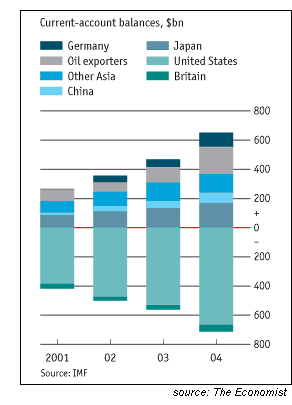 In Tuesday's entry, I suggested a metaphorical connection between the explosion of
obesity in the U.S. and a similar explosion in debt. But are the risks of both
conditions overblown?
In Tuesday's entry, I suggested a metaphorical connection between the explosion of
obesity in the U.S. and a similar explosion in debt. But are the risks of both
conditions overblown?
Many experts are questioning whether obesity is really all that bad for most people. Under rigorous analysis, the statistical relations between mortality and being overweight (i.e. dying youngerer than non-obese people) are not entirely convincing, as this piece in Scientific American outlines: is the risk of obesity overblown? When Flegal and her co-workers analyzed just the most recent survey, which measured heights and weights from 1988 to 1994 and deaths up to 2000, even severe obesity failed to show up as a statistically significant mortality risk. It seems probable, Flegal speculates, that in recent decades improvements in medical care have reduced the mortality level associated with obesity. That would square, she observes, with both the unbroken rise in life expectancies and the uninterrupted fall in death rates attributed to heart disease and stroke throughout the entire 25-year spike in obesity in the U.S.So is fat getting a bum rap? Clearly, obesity and its relationship to health and disease is a dynamic, hard-to-pin-down set of complex interactions. There is even evidence that a certain virus may trigger accumulations of fat, even in animals which don't eat more or exercise less: some cases of obesity may be caused by a viral infection. Modest amounts of fat, it seems, may enable the elderly to bounce back from certain diseases. So the picture on fat is anything but simple. But that doesn't mean that being overweight has no downside; you can start with the basic physics of what carrying around an extra 50 pounds for a few decades does to knees and joints: not good. While skeptics can argue around the edges of the issue, intuitively we all know that being obese isn't good for you. It may not kill you, but that doesn't mean it's risk-free. In an analogous fashion, Wall Street pundits and D.C. politicos have argued for years that unprecedented levels of government and private debt are actually quite benign; in other words, they pose no risk to the great American economy. And ditto, of course, for the unprecedented trade deficit (chart above); according to the CIA factbooK, America's current account deficit is a staggering $829 billion for 2005. This huge imbalance is mirrored by the abysmal negative savings rate and rising consumer spending which has held sway throughout 2005: The Commerce Department reported Monday that personal income increased at a seasonally adjusted rate of 0.4%... But December personal consumption grew 0.9% after a revised 0.5% increase the prior month... Personal saving as a percentage of disposable personal income was negative 0.7% in December. The rate has been in negative territory eight times in nine months and was negative 0.2% in November. The savings rate for all of 2005 was negative 0.5%, the lowest annual savings rate since a decline of 1.5% in 1933.So we're left wondering: is the American economic diet of massive debt and massive deficits really benign, or has the "medicine" of cheap, plentiful money and low interest rates simply obscured the risks? Isn't it analogous to controlling high blood pressure with a handful of pills, and reckoning that this is practically as good as being fit? But being fit and popping pills (or adding new debt) is not the same; it seems clear that Americans are solving their lack of savings and income by borrowing, and solving the high costs of paying interest by borrowing more. It's difficult to believe that such gargantuan debts and deficits can continue indefinitely without a day of reckoning ever dawning. Perhaps it is finally sunrise on that day. February 1, 2006 Kroika! Ad Three: A Kroika Friendship  The Kroika Marketing crew felt my first two ads had overly negative
subtexts, so Ad Number Three is on a suitably marketable topic: friendship.
The Kroika Marketing crew felt my first two ads had overly negative
subtexts, so Ad Number Three is on a suitably marketable topic: friendship.
I suppose some might think that the Politburo trial of a Gang of Four member and a tense cold war showdown were inappropriate subtexts for the bright levity of a Kroika ad; and so while I retain full editorial and creative control of this site, I'm certainly willing to listen to differing points of view. So here we have a subtext of a warm friendship growing despite huge differences in ideology, temperament and nuclear capabilities. What could be warmer or fuzzier? And how do new good pals celebrate? With a crisp Kroika cookie, of course! And who magically appears to transform a warm moment into a truly special Kroika Moment? The Kroika Lady and her Very Special Gong, of course. Unbeknownst to the marketing mavens over in Xiangxi, all my Kroika ads are very carefully designed to build an irresistable "brand identity" for Kroika. As you probably know, thousands upon thousands of extremely bright and talented people toil away in large marketing and advertising agencies around the globe, trying to subtlely coerce you into identifying wonderful, uplifting, happy feelings with various products. For instance, Apple Computer's logo, a brightly striped apple, has a bite taken out of it, suggesting a rebellious, or even subversive "breaking all the rules" attitude. (Never mind what happened to Eve, who actually took the first bite of the knowledge of good and evil; cast out of Eden indeed!) Then there was Apple's "think different" campaign (even the questionable grammar was part of that rebellious "think differently" Apple archetype): the ads said, if you buy an Apple, then you're identifying with the wild geniuses pictured in the ads. Heck, you're probably a wild, undiscovered genius yourself! Wow. who wouldn't plop down a mere $2,000 in order to join the ranks of Gandhi, Feynman, Ansel Adams or the other greats depicted in the campaign. As an Apple owner since 1985, I have to admit I've fallen for their slick marketing from the very start. Yes, they had a vastly superior product, too, but we all paid a huge premium for that quality. I recall reading that Apple was netting a thousand bucks a Mac back in the good old days--back when $1,000 was real money--the equivalent of $1,800 in today's money. Never mind that once you enter the cult of Mac ownership, the software and hardware upgrades are both expensive and endless, and your previously favorite programs no longer work on your new Apple. The bottom line is that brilliant marketing makes you feel awfully good and awfully special every time you turn on your Mac, and as a result you gladly pay a truly enormous premium (otherwise known as pure profit) for the privilege of owning a Mac. (Note: I have resisted the iPod Podpeople ads, and the siren's song of the new Macs. I work a lot on my cheapo WinXP machine because it's so much quicker than my old Mac.) Here's one hint about the secret workings of my Kroika ads: the primitve, slapped-together "look and feel" is entirely calculated to give the ads a rough-hewn, almost child-like authenticity. You don't feel conned by such an unslick, amateurish ad. Looking at Kroika ads is a guilty pleasure in and of itself because they're so bad and so hokey. There are all sorts of other secret messages embedded in each simple little Kroika ad, but I'm not going to reveal any more of the inner workings at the moment. Just enjoy the ads as brief little primitive movies. And don't you wish you had a crunchy Kroika in your hot ltitle hands right now? wEssay noun, combination of 'web' and 'essay,' denoting a short online essay which exploits the hyperlinks, interfaces and interactive capabilities of the World Wide Web; coined by Charles Hugh Smith on May 1, 2005, in Berkeley California. copyright © 2006 Charles Hugh Smith. All rights reserved in all media. |
Subscribe via RSS: search my site: |
||
|
Our retail policy: Nothing is for sale except books/films I recommend (via links to Amazon.com) Free alternative: check them out at your local library |
home |